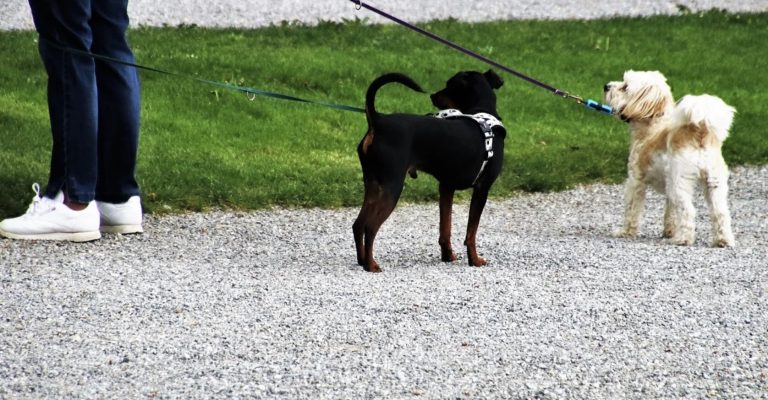I can bet any dog owner has done it at one point. I have done it a few times as well. Sometimes, stress and panic can take over. But I feel sorry for my mistakes. That is why I am trying to tell people and advise them against leash jerks. Leash walking should be pleasant for both you and your dog.
If you do not have the confidence in your dog to walk off-lead, you can always implement loose leash walking. Sometimes, off-lead walking is just not possible. I know, I live in a big city as well. Cars, streets, people all around, cats, and what more.
That is why Milo walks on a loose leash in the city. But when we are in nature, he gets to enjoy his off-lead freedom.
With that in mind, when you walk your dog on a leash, leash jerks can do so much damage. It hurts your training and your dog’s health as well.
Many years ago, someone might have told you that if your dog does something you do not like, it is appropriate to jerk his collar. Well, jerking has become so ingrained in many of us, that we do not even think about it anymore. We just react. And that is wrong.
What is the problem with leash jerks?
The big problem with a sudden jerk is that it doesn’t solve the underlying cause of the problem. It only suppresses it. Or in other words, it doesn’t cure the disease, it only treats the symptoms of it.
Even worse, leash jerking might cause your dog to act aggressively. In many cases, dogs on a tight leash often bark and growl at another dog. So, basically, what you are doing with your sudden leash is train a reactive dog. Your dog feels threatened when you hold them tight.
Do not label it as aggressive behavior on a leash. That is your next mistake. The accurate way to describe the situation is “fear-based aggression due to feeling threatened”. Or to put it simply, your dog acts out in response.
We will get more into the neck injury problems related to leash jerking, but for now, consider the biggest problem your dog’s aggressive behavior.
How to prevent your dog from developing reactivity
As I mentioned before, many dog owners do not understand that they have caused aggressive behavior and reactivity in their dog. How? They are misinterpreting their dog’s playful and curious behavior toward other dogs.
Here is one example. You have your dog on a loose leash and you are walking. Your puppy becomes energetic and wants to move toward that dog and say hello. But instead of allowing it to happen, you put your dog on a tight leash. You have “corrected” the behavior.
This might stop your dog from approaching an unfamiliar dog. But you are unintentionally teaching your puppy to associate an unfamiliar dog with a punishment.
The next time you walk your dog and you are approaching an unfamiliar puppy, your dog will anticipate the jerk. And the type of punishment becomes a conditioned cue for punishment. Your pup will no longer want to greet any unfamiliar dog or let alone play with it.
So, what happens when you jerk?
To understand why you should stop using jerking and focus more on positive reinforcement, let’s talk about what actually happens.
Many dog owners have been taught that in response to bad or negative dog behavior, it is best that you jerk. Yes, sometimes it might produce the desired result. Hey, you can get lucky once or twice. The dog will stop acting out.
But do not think, “Hey this works, I should do it every time I need it”. Ask yourself, “does jerking solve the problem permanently”? Of course not. Your dog might do something similar again, and you will have to jerk again.
And if your answer to the problem and solution is jerk again, then it is not a solution. It is an unfair and inhumane thing to do to your dog.
When you jerk his leash, you may SUPPRESS a behavior, but you will not correct its behavior. There is a difference between suppressing a behavior and changing behavior. For the second, I highly recommend positive reinforcement training.
Say you have a reactive dog. When your dog is about to meet another dog, your puppy feels anxious. But stops when you jerk on the leash. Yet, your puppy doesn’t stop because it thinks it did something wrong. Your pup stops because it feels pressure, discomfort, and pain around its neck. Your dog still has anxiety. So, you haven’t solved the problem.
The Only Time You might use leash jerking
Sometimes, it is fine to use leash correction during training. That is one of the ways balance training teaches us. But remember, it is not just jerk, jerk, and jerk more.
In balanced training, the point with punishment, in this case, leash correction, is to shift your dog’s focus towards what you want him to do.
And even in that case, you should only use leash jerk when you use voice first. The path is voice command or voice correction and then leash jerk.
This way your dog actually learns something. If you just jerk him without using a voice or command, your dog will not learn anything. And you are not allowing your dog to learn anything.
The Health Reasons to Stop Jerking
Let’s finish off our article about the problems with leash jerking with health issues. It is even more incentive to stop jerking. If everything I wrote about above is not enough for you to stop jerking your dog, consider this.
In 1991, Anders Hallgren did an extensive study on the physical injuries related to jerking and pulling on leash. The results were alarming.
More than 90% of the dogs that had neck injury have been exposed to jerking and pulling on the lead by their dog owner. They have also been allowed to pull hard on the leash for long periods.
The mistake we make is thinking our dog’s neck is rough and can handle the jerking. But that is not true. Dogs with long spines, like Dachshund for example, are even more susceptible to neck problems. But these injuries can strike any dog.







